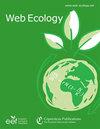在弹珠被解开的过程中。鲁弗斯复合体(腹足纲):新的遗传途径
IF 2.3
3区 环境科学与生态学
Q2 ECOLOGY
引用次数: 5
摘要
摘要Arion属包括几种蛞蝓,其中一些被认为对栽培和野生植物都是有害的。在该属中,Arion ater复合体包括两种不同的形态:Arion rufus和A. ater,但它们的物种地位尚未达成共识。它们的系统发育关系最近得到了解决,它们都属于不同的系统发育分支,但它们的物种地位仍然不清楚(因为不同的分支并不总是不同的物种)。出于这个原因,本研究的目的是通过采用最新的多速率泊松树过程(mPTP)方法以及经典的遗传距离方法来精确识别这些物种状态,这两种方法都有三个不同的线粒体基因。结果证实了两者。ater和A. rufus是独立的进化分支,它们之间的高遗传距离(K2P距离在9.1 - 16.4%之间,取决于基因)以及mPTP分析支持了这两个分支对应于不同物种的观点。研究结果将有助于这些特定物种的分类,以及制定适当的害虫防治方法和保护政策。本文章由计算机程序翻译,如有差异,请以英文原文为准。
Towards the unravelling of the slug A. ater–A. rufus complex (Gastropoda Arionidae): new genetic approaches
Abstract. The genus Arion includes several slug species, some of which are
considered to be a pest to both cultivated and wild flora. Within this genus,
the Arion ater complex comprises two different morphological forms:
Arion rufus and A. ater, but there is no consensus about
their species status. Their phylogenetic relationships have been recently
solved, both of them belonging to different phylogenetic clades, but their
species status is still unclear (as different clades are not always different
species). For this reason, the aim of this study was to precisely identify these species
status by employing the up-to-date multi-rate Poisson tree processes (mPTP)
methodology as well as the classic methodology of genetic distances, both of
which have three different mitochondrial genes. Results confirmed that both
A. ater and A. rufus are independent evolutionary clades,
and the high genetic distances between them (K2P distances ranged between 9.1
and 16.4 %, depending on genes) together with mPTP analyses, supported
the idea that the clades correspond to different species. Results will be
useful for the classification of these specific species as well as for
developing proper pest control methodologies and conservation policies in
both cultivated and wild plants.
求助全文
通过发布文献求助,成功后即可免费获取论文全文。
去求助
来源期刊

Web Ecology
Agricultural and Biological Sciences-Ecology, Evolution, Behavior and Systematics
CiteScore
4.60
自引率
0.00%
发文量
6
审稿时长
17 weeks
期刊介绍:
Web Ecology (WE) is an open-access journal issued by the European Ecological Federation (EEF) representing the ecological societies within Europe and associated members. Its special value is to serve as a publication forum for national ecological societies that do not maintain their own society journal. Web Ecology publishes papers from all fields of ecology without any geographic restriction. It is a forum to communicate results of experimental, theoretical, and descriptive studies of general interest to an international audience. Original contributions, short communications, and reviews on ecological research on all kinds of organisms and ecosystems are welcome as well as papers that express emerging ideas and concepts with a sound scientific background.
 求助内容:
求助内容: 应助结果提醒方式:
应助结果提醒方式:


